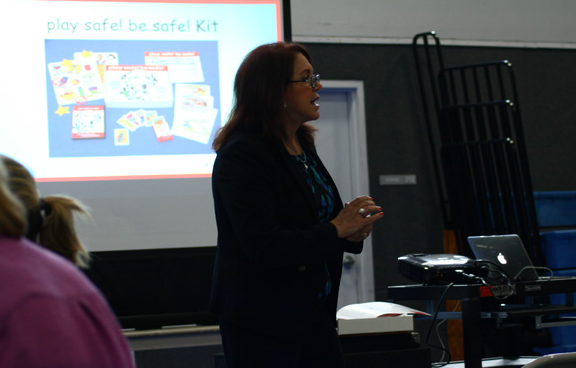Workshop organizer Molly Clifford speaks at Play Safe! Be Safe! workshop in PA. Photo by Dean Bear.
Fire safety instructors are looking to give firefighting personnel some insight into how children view fire safety, and why young boys start more fires than girls.
It’s all a part of the Play Safe! Be Safe! Workshop in Prince Albert, which is looking to help people understand the challenges that come up when discussing fire safety with children.
Recent statistics show that children playing with fire led to over 49,000 reported fires every year and in most cases (88%) injuries connected with fires started at home.
Molly Clifford is the workshop organizer from Rochester, New York and says many children are naturally curious about fire.
However, they don’t really understand the danger.
As for why young boys end up starting more fires than girls, she says that boys are usually more of the risk takers and they are naturally curious about fire.
“But that is not to say that there aren’t girls interested as well,” she added.
And she says that in a majority of the cases in studies in Rochester, the state of Oregon and in Surrey, B.C., the average age of children playing with fire and starting structure blazes was 12 years old and younger.
“Sometimes we think that children are basically little adults, so we can just tell them, don’t touch fire. It can hurt you. It’s dangerous. You need to stay away,” Clifford explained. “They know that its something that they shouldn’t do, like so many of the rules that parents give them, but they don’t really know why.”
Clifford is a former Director of Fire Administration with the Rochester Fire Department in New York, where she worked on fire prevention programs, code enforcement and community outreach. She started teaching Play Safe! Be Safe! workshops roughly 20 years ago, and says many children are naturally curious about fire. However, they don’t really understand the danger.
Clifford says educating kids at an early age is crucial to teaching them that lighters and matches are not things to be played with.
And she says working with local fire departments will help get that message out to school-aged kids who are at the stage that they want to mimic or copy what their parents and adults do.
“What we try to have the firefighters take away from these workshops is that fire is all around young children and it isn’t a toy to be played with and kids look up to firefighters,” she said. “They are always involved in the community, so they are the best people to deliver the fire safety message.”
Clifford says the role of the family in providing a safe environment and in reinforcing the lessons being taught to the children is critical. And she says specific parental responsibilities are identified as are strategies designed to encourage parents to actively participate in fire safety.
This is the only Play Safe! Be Safe! workshop being delivered in Canada, which was put on at the request of the Saskatchewan Fire Chiefs Association.
